It’s 2023. It’s Time to Hire a DEI Director and Kick Off Meaningful DEI Programs. Here’s How.
Add bookmark
Diversity, Equity and Inclusion are More Important Than Ever
Although it remains true that DEI increases profitability, some companies remain unconvinced. The hard truth? If you aren’t ready to embrace DEI initiatives and professionals, then you may not be ready to overcome your competitors in the metaverse era.
Here are the facts:
The number of “minority” workers doubled between 1980 and 2020. Groups historically considered “minority” will reach majority status in the next two decades. The millennial and Gen Z generations are the most diverse and liberal in history. Millennials will comprise 75% of America’s workforce within the next three years.
In addition, more than half of all workers believe their company needs to improve diversity, more than 75% of job seekers are actively seeking out companies distinguished for their diversity and seven in 10 executives are already prioritizing diversity, equity and inclusion.
Nevertheless, and even with a record number of companies announcing an increased commitment to racial and social justice, “those commitments have not yet translated into tangible results,” according to the World Economic Forum.
In fact, only one in five companies “holds itself accountable for DEI in its business practices” and 40% still see diversity as “primarily an issue of compliance.”
Why? One reason is that “only 4% of HR professionals even feel proficient enough to lead corporate DEI programs” — leaving open a lucrative opportunity for a new type of leader, one focused entirely on equity, inclusion and team morale.

5 Steps to Fostering DEI and Developing Company Culture in Your Organization in 2023
1. It’s Time to Hire a Director of Diversity, Equity and Inclusion.
As Emily Galvin-Almanza, founder and executive director of Partners for Justice, told me, “Culture change is harder than a DEI training. It requires materially improving the conditions of employment in a way that is responsive to the stated needs of staff.”
For Alan Detlaff, dean of the University of Houston’s Graduate College of Social Work, “DEI is not the same as justice; the expectation for DEI literally needs to be the floor.” And Howard Henderson, Brookings Institute senior fellow and director of the Center for Justice Research at Texas Southern, added that, with “retaliation against complainers” being “enough to deter any serious complaints,” the DEI director is “a joke” unless “they report directly to the CEO” and forward all complaints to an unaffiliated third party for investigation.
In other words, DEI is complicated, and you shouldn’t do it alone.
Fortunately, a number of innovative, considerate and effective professionals have positioned themselves as thought leaders in the broadening DEI space — and rightfully so.
1. Start with the LinkedIn Top Voices in leadership, disability and advocacy, social impact, LGBTQ+, mental health, “next gen,” company culture, racial equity, and gender equity.
2. Reach out, schedule meetings, and solicit advice.
3. Be willing to pay a consultancy fee.
4. Be flexible and open minded.
5. Take copious notes on the individuals whose experience, expertise, values and mission most closely align with yours.
You may find your first DEI director; or, at the very least, you’ll know exactly which type of DEI director you’re looking for.
Is there anyone at your organization who meets your criteria for DEI director? How about your competitors?
Hint: they don’t have to come from HR or have professional DEI experience.
Here’s proof:
- Walmart’s chief culture, diversity, equity and inclusion officer, Ben Saba-Hasan, was an IT leader before taking on his latest role.
- The chief equality and recruiting officer for Salesforce, Tony Prophet, worked in marketing and operations.
- Zoom’s first-ever chief diversity officer, Damien Hooper-Campbell, has a background in finance.
So, as Mita Mallick, a LinkedIn Top Voice, suggests:
“Instead of looking for direct senior DEI leadership experience, consider people with broader backgrounds but all the right skills: the ability to influence and be a change agent, to design strategy and deliver results, to create metrics and drive accountability, and to communicate effectively across all levels of the hierarchy. Those with marketing, sales, or communications backgrounds might be a great fit. Also consider people who have been informal D&I champions or, more specifically, have served as an executive sponsor for an employee resource group. You don’t have to be a career HR professional to do this work.”
Once onboarded, your DEI director should lead Steps 2-4.

2. Do your research
First, research yourself.
- Ensure you’re measuring your DEI efforts against the right KPIs, including (a) percentage of representation on your organization’s board, (b) percentage of representation by employee category, and (c) pay equality, or the ratio of compensation by employee category (i.e., equal pay for equal work), along with promotion and turnover rates, percentage of participation in ERGs (see below), and supplier diversity. Develop an internal dashboard for tracking, analysis and reporting. Continually analyze and adjust for gaps and opportunities in your employee recruitment, hiring, development and advancement efforts.
- Survey your staff on issues of fairness, discrimination, personal belonging, trust, respect and purpose, decision making, hiring and onboarding, diversity and inclusion, and opportunities and resources (equity). Then, analyze for gaps and opportunities in your employee recruitment, hiring, development and advancement efforts.
Second, research what works and what doesn’t.
- Which companies are doing DEI correctly, such as Target, Chevron, Microsoft, SAP or Ultimate Software Group)?
- Which DEI leaders’ particular expertise seems to most closely align with your organization’s values and value statement?
No two companies are alike, but there are lessons to be learned from every successful — and failed — attempt at DEI. And, as we know, there are a variety of ways to leverage the skills and experiences of those who’ve encountered it before.
3. Inspire alignment
As we now know, there’s no use in forcing anyone to undergo diversity training. For your DEI initiative to work, it must be supported by your people — and the only way to earn their buy-in is to demonstrate the need and the value, or the problem and the solution.
The problem for most organizations is insufficient diversity (a recruiting and hiring issue), equity (a hiring, training, development and advancement issue) and inclusion (a company culture issue); the need is improvement in all three areas.
The value of thoughtfully constructed DEI programs can be seen in successes across industries and geographies, and the solution is to work together under the leadership of your director of diversity, equity and inclusion to customize a program that would benefit the organization and all its employees — and, specifically, employees who historically wouldn’t have felt respected, valued or part of the group.
Here’s how to run a DEI program aligned with your employees’ interests and needs:
- Kick off the program and initiate the discussion with a town hall on the interests, challenges and biases identified in the companywide survey
- Ask participants to contribute ideas to the development of the program
- Develop the program and distribute details internally, requesting feedback online
- Finalize the program
- Celebrate your alignment and new commitment through public relations, marketing and advertising campaigns aimed at potential new employees and customers
- Ensure your management team never forgets the why behind it all.

4. Build an equitable, inclusive culture from the ground up
- Create DEI task forces with employees from all levels of the organization
- Create employee resource groups (ERGs) for employees who share a common characteristic, such as race, ethnicity, gender, generation or religious affiliation, to provide support and expand professional networking and career development opportunities
- Create a public-facing digital scorecard measuring and showcasing your DEI metrics over time
- Develop DEI policies for managers and staff, including a code of conduct policy, outlining the company’s policy on diversity, equity inclusion; a communication plan, outlining non-discriminatory communication practices; a non-discrimination policy, outlining discrimination laws and what is not allowed in the workplace; a zero-tolerance policy, outlining how instances of discrimination, harassment, bullying and stereotyping will be addressed by the organization; and a grievance policy, outlining how employees can use the company alternative complaint system (see below)
- Develop DEI workshops from the inside out, leveraging your lead learners in the creation of each workshop and training, encouraging the hard conversations; collecting all perspectives, prioritizing members of historically disenfranchised groups; promoting intersectionality, or the interconnected nature of social categorizations such as race, class, gender and sexuality in overlapping and interdependent systems of discrimination or disadvantage; focusing on intervention and not just bias reduction; and facilitating ongoing engagement through lead learner-led one-on-one meetings, workshops and town halls, as well as diversity-related outreach programs and informal information sharing
- Create safe spaces in your workplace, such as gender-neutral restrooms for non-binary and genderqueer individuals, lactation rooms for new mothers, prayer or meditation spaces and quiet workspaces for workers who may be distracted or overstimulated by open-floor-plan seating; if you’re fully remote or have some staff working from home, you can create safe ‘spaces’ digitally by encouraging employees to add pronouns to their email signatures and usernames, inviting employees to reserve time for personal needs by blocking it out on the calendar, and honoring introverts by making digital culture events optional
- Deploy an alternative complaint system (without one, half of all discrimination and harassment complaints lead to retaliation), providing employees with access to an employee assistance plan (EAP) for anonymous, free support, as well as implementing transformative mediation, designed to empower all parties and ensure each party recognizes the other’s needs, interests, values and points of view

5. Start recruiting, interviewing, hiring, onboarding and developing talent with a focus on diversity, equity and inclusion
The first step is to reassess. Audit and update your website, social media accounts, content marketing and advertising to prominently highlight your commitment to doing DEI the right way.
After you realign your voice with your goals, you can follow these steps for a more equitable hiring process:
- Write more inclusive job descriptions.
- Limit employee referrals.
- Diversify your talent pipeline by hosting online and in-person events targeting diverse populations; leveraging your ERGs to better understand biases and barriers; and continually collecting and analyzing data, pivoting as necessary.
- Incorporate a diverse interview panel to ensure candidates are chosen solely based on suitability.
- Train interview panelists not to ask questions about age, race, ethnicity, gender, sexuality, religion, country of origin, birthplace, address, arrest record, citizenship, credit rating, financial status, height or weight, disability, marital status, family status, or pregnancy.
- Evaluate and update welcome packages to ensure there is nothing biased, discriminatory or potentially offensive to new hires.
- Prioritize diversity, equity and inclusion throughout the onboarding process.
- Train managers and HR staff on how to provide equitable access to resources and opportunities.
- Coach teams on how to be inclusive to new hires.
Need Help Highlighting DEI with Authenticity and Transparency? How About Targeting the Right Potential Employees or Customers?
At CCWomen, we want to know what your company is doing to kick off thoughtful DEI programs in 2023. Want to learn more? Email us at ccwomen@cmpteam.com.


























